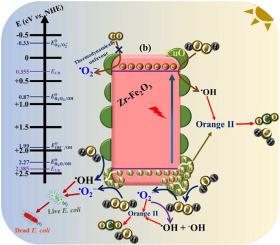Sustainable water treatment using CuO Cocatalyst–loaded Zr-doped Fe2O3 nanocomposite for oxidant-free photocatalytic degradation of Orange II dye and E. coli inactivation
IF 4.7
3区 材料科学
Q2 MATERIALS SCIENCE, MULTIDISCIPLINARY
引用次数: 0
Abstract
Photocatalytic dye degradation and bacterial inactivation are considered potentially effective approaches to mitigate the adverse effects of hazardous pollutants and biohazards on human health. Hence, we aim to investigate the synthesis, kinetics of adsorption and photocatalytic performance of a CuO-cocatalyst-loaded Zr-doped Fe2O3 nanocomposite (1-CuO/Zr-HT) in the context of its effectiveness against Orange II dye and E. coli without the addition of an oxidant. Zr-doping was achieved by in-situ hydrothermal and a subsequent wet impregnation method was employed for CuO cocatalyst loading. The maximum adsorption capacity (qe) was determined to be 8.395 mg/g for the optimized 1-CuO/Zr-HT, which attained a degradation efficiency of 95.9% for Orange II within 150 min. CuO-loading enhanced the specific surface area as well as decreased the pore volume, which are responsible for enhanced active sites for effective photocatalytic reaction. We investigated the orange II dye degradation with varying adsorbent dosage, initial dye concentration and initial pH. The results of the scavenger test and mechanistic evaluation revealed that the degradation of Orange II is attributed to the holes, •O2− and •OH produced during the photocatalytic process. The Orange II elimination process by 1-CuO/Zr-HT followed a pseudo-second order (PSO) kinetic parameter with a correlation coefficient (R2) of 0.99972. Furthermore, the 2-CuO/Zr-HT nanocomposite achieved a deactivation rate of 99.1% for E. coli after 120 min of illumination. The results illustrate the effectiveness of the suggested strategy for the decomposition of Orange II dye in water, indicating its potential as a viable and environmentally sustainable solution for the remediation of organic/antibiotic-contaminated water.

CuO负载zr掺杂Fe2O3纳米复合材料可持续水处理的无氧化光催化降解橙II染料和大肠杆菌灭活
光催化染料降解和细菌灭活被认为是减轻有害污染物和生物危害对人类健康不利影响的潜在有效方法。因此,我们的目的是研究负载cuo共催化剂的zr掺杂Fe2O3纳米复合材料(1-CuO/Zr-HT)的合成、吸附动力学和光催化性能,并在不添加氧化剂的情况下对橙色II染料和大肠杆菌的有效性进行研究。采用原位水热法掺杂zr,随后采用湿浸渍法加载CuO助催化剂。优化后的1-CuO/Zr-HT的最大吸附量为8.395 mg/g,在150 min内对橙ⅱ的降解率为95.9%。负载cuo增加了比表面积,减少了孔体积,从而增加了有效光催化反应的活性位点。研究了不同吸附剂用量、初始染料浓度和初始ph对橙色II染料的降解作用。清除剂试验和机理评价结果表明,橙色II染料的降解主要归因于光催化过程中产生的空穴、•O2−和•OH。1-CuO/Zr-HT去除Orange II的过程符合准二阶动力学参数,相关系数(R2)为0.99972。此外,2-CuO/Zr-HT纳米复合材料在120 min的光照下对大肠杆菌的失活率达到99.1%。结果表明,建议的策略在水中分解橙色II染料的有效性,表明它可能是一种可行的、环境可持续的解决方案,用于修复有机/抗生素污染的水。
本文章由计算机程序翻译,如有差异,请以英文原文为准。
求助全文
约1分钟内获得全文
求助全文
来源期刊

Materials Chemistry and Physics
工程技术-材料科学:综合
CiteScore
8.70
自引率
4.30%
发文量
1515
审稿时长
69 days
期刊介绍:
Materials Chemistry and Physics is devoted to short communications, full-length research papers and feature articles on interrelationships among structure, properties, processing and performance of materials. The Editors welcome manuscripts on thin films, surface and interface science, materials degradation and reliability, metallurgy, semiconductors and optoelectronic materials, fine ceramics, magnetics, superconductors, specialty polymers, nano-materials and composite materials.
 求助内容:
求助内容: 应助结果提醒方式:
应助结果提醒方式:


